The Wolf– Reality and Mythology –17:01 May 18 2007
Times Read: 865
The Wolf
– Reality and Mythology –
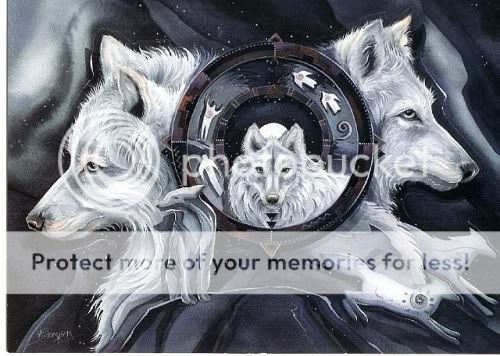
Facts about the Wolf
The Wolf (also known as Gray Wolf or Timber Wolf) is a mammal in the order Carnivora. He inhabits large areas in Asia and Canada, but in Europe and Middle East the wolf is threaten by extinction.
The Wolf, being a keystone predator, is an important part of the ecosystems to which it typically belongs. The wide range of habitats where wolves thrive reflects their adaptability as a species, and includes temperate forests, mountains, tundra, taiga, and grasslands.
His adaptability, his endurance to extreme temperatures, his good hearing sight, his excellent eye sight that allows him to see good at night, and his excellent smell sight that is 1000 times better then a normal human’s make him a powerful adversary and an good predator.
The modern wolf appeared almost 800.000 years ago, in South East Asia and spread in to the northern hemisphere. During the Late Pleistocene (300,000 years ago) the Wolf crossed into North America via the Bering Strait land bridge.
The weight and size of the Gray Wolf can vary greatly worldwide, and tend to increase proportionally with latitude. Generally speaking, height varies from 0.6–0.9 meters (26–34 inches) at the shoulder, and weight from 32–62 kilograms (70–135 pounds), which together make Gray Wolves the largest of all wild canids.
Although rarely encountered, extreme specimens of more than 77 kg (170 lb) have been recorded in Alaska and Canada; the heaviest wild wolf on record, which was killed in Alaska in 1939, was 80 kg (175 lb). There are some unconfirmed reports of wolves hunted in North Eastern Russia reaching weights of 100 kg. (220 lb). Females in a given population typically weigh about 20% less than their male counterparts. Wolves can measure anywhere from 1.3–2 meters (4.5–6.5 feet) from nose to the tip of the tail, which itself accounts for approximately one quarter of overall body length.
Wolves are built for stamina, possessing features ideal for long-distance travel. They are capable of covering several miles trotting at about a pace of 10 km/h (6 mph), and have been known to reach speeds approaching 65 km/h (40 mph) during a chase.
A wolf sometimes seems heavier than it actually is due to its bulky coat, which is made of two layers. The first layer consists of tough guard hairs designed to repel water and dirt. The second is a dense, water-resistant undercoat that insulates the wolf. Wolves have distinct winter and summer pelages that alternate in spring and autumn. Females tend to keep their winter coats further into the spring than males.
Coloration varies greatly: it runs from gray to gray-brown, all the way through the canine spectrum of white, red, brown, and black.
Fur color sometimes corresponds with a given wolf population's environment; for example, all-white wolves are much more common in areas with perennial snow cover. Aging wolves acquire a grayish tint in their coats.

At birth, wolf pups tend to have darker fur and blue eyes that will change to a yellow-gold or orange color when the pups are 8–16 weeks old. Though extremely unusual, it is possible for an adult wolf to retain its blue-colored eyes.
Wolves and larger dogs share identical dentition; the maxilla has six incisors, two canines, eight premolars, and four molars. The mandible has six incisors, two canines, eight premolars, and six molars. The fourth upper premolars and first lower molars constitute the carnassial teeth, which are essential tools for shearing flesh. The long canine teeth are also important, in that they are designed to hold and subdue the prey. Powered by 1500 lb/sq. inch (~10 MPa) of pressure, a wolf's teeth are its main weapons as well as its primary tools.
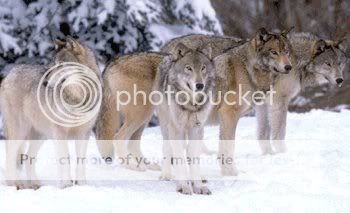
Wolves function as social predators and hunt in packs organized according to strict, rank-oriented social hierarchies. The pack is led by the two individuals that sit atop the social hierarchy: the alpha male and the alpha female.
During the mating season, (mating occurs between January and April — the higher the latitude, the later it occurs) the alpha male and alpha female may be forced to aggressively prevent other wolves from mating with one other. Under normal circumstances, a pack can only support one litter per year; usually, only the alpha pair is able to successfully rear a litter of pups. There are 1 to 14 pups per litter; the average litter size is about 4 to 6. Pups reside in the den, where they are born deaf with their eyes closed, and stay there until they reach about three weeks of age.
All the wolves in the pack assist in raising wolf pups. Some mature individuals, usually females, may choose to stay in the original pack so as to reinforce it and help rear more pups. However, most will disperse.
Wolves typically reach sexual maturity after two or three years, when many of them will be compelled to leave their birth packs and seek out mates and their own territories.
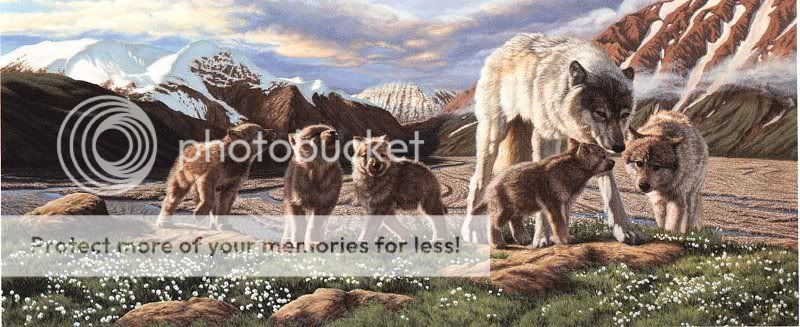
Once two wolves meet and begin traveling together, they immediately begin the process of seeking out territory, preferably in time for the next mating season. The bond that forms between these wolves often lasts until one of them dies — with few exceptions.
The size of the pack may change over time and is controlled by several factors, including habitat, personalities of individual wolves within a pack, and food supply. Packs can contain from 2 to 20 wolves, though an average pack consists of about 8.
After the alpha pair, there may also, especially in larger packs, be a beta wolf or wolves, a "second-in-command" to the alphas. Also one wolf will assume the role of the omega: the lowest-ranking member of a pack.
For wolves, camaraderie is preferable to solitude.
Wolves are highly intelligent creatures that use a sophisticated system of body language, howls other sounds (growling or barking).Wolves can visually communicate with an impressive variety of expressions and moods ranging from subtle signals, such as a slight shift in weight, to more obvious ones, such as rolling on their backs to indicate complete submission.
Howling helps pack members keep in touch, allowing them to communicate effectively in thickly forested areas or over great distances. Howling also helps to call pack members to a specific location. Howling can also serve as a declaration of territory. Wolves will also howl for communal reasons. Some scientists speculate that such group sessions strengthen the wolves' social bonds and camaraderie— similar to community singing among humans. A wolf's howl may be heard from up to ten miles away, depending on weather conditions. Observations of wolf packs suggest that howling occurs most often during the twilight hours, preceding the adults' departure to the hunt and following their return.

Packs of wolves cooperatively hunt any large herbivores in their range. Pack hunting revolves around the chase, as wolves are able to run for long periods before relenting.
When pursuing large prey, wolves generally attack from all angles, targeting the necks and sides of their prey. Wolves' diet includes, but is not limited to, elk, caribou, moose, Sambar Deer, and other large ungulates. The American Bison is probably the largest animal wolves prey on; bison weighing more than a ton have been taken down by a pack. They also prey on rodents, small animals, and other canids like foxes and coyotes in a limited manner, for a typical adult wolf requires a minimum of 1.1 kg (2.5 lb) of food each day for sustenance.
Wolves generally live 6 to 8 years in the wild, although in captivity they can live to twice that age. High mortality rates give them a low overall life expectancy. Pups die when food is scarce; they can also fall prey to predators such as bears, or, less often, coyotes, foxes, or other wolves. The most significant causes of mortality for grown wolves are hunting and poaching, car accidents, and wounds inflicted while hunting prey. Although adult wolves may occasionally be killed by other predators, rival wolf packs are often their most dangerous non-human enemy. A study on wolf mortality came up with results indicating that 14% to 65% of wolf deaths were due to other wolves. Wolves are susceptible to the same infections that affect domestic dogs, such as mange, heartworm, rabies and canine distemper.

Relationships with other predators
One of the most well researched wolf/predator interactions is that involving the Coyote. Wolves are generally intolerant of Coyotes in their territory, seeing them as competitors for food and as threats to their cubs. Though smaller in size and not as fast, Coyotes are usually swift enough to escape the jaws of Wolves and on some occasions, have even been known to gang up on them. Near identical interactions have been observed in Greece between Wolves and Golden Jackals.

The Cougar is another predator encountered by the Gray Wolf in North America. As with the Coyote, the Gray Wolf is usually hostile toward the big cats and will kill kittens, as well as adults when working in a pack. A wolf stands little chance against a cougar on a one to one basis.
Brown bears are among the few competitors wolves encounter in both Eurasia and North America, while the American Black Bear is encountered solely in America. The majority of interactions between wolves and bears usually amount to nothing more than mutual avoidance. Serious confrontations depend on a variety of variables, though the most common factor is defence of food and young. Bears will use their superior size to intimidate wolves from their kills and when sufficiently hungry, will raid wolf dens. Wolves in turn have been observed killing bear cubs, to the extent of even driving off the defending mother bears. Deaths in wolf/bear skirmishes are however considered very rare occurences, the individual power of the bear and the collective strength of the wolf pack usually being sufficient deterrents to both sides.
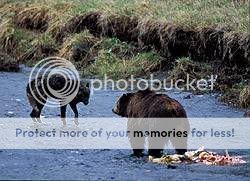
In Russia, the Gray Wolf's status as an apex predator is competed by the Siberian Tiger. Siberian Tigers have been known to prey on Wolves and will sometimes hunt them to remove competition for the limited prey base. Studies have shown that Gray Wolf populations generally decrease in areas inhabited by the Siberian Tiger.
In some Middle Eastern countries, the Gray Wolf will sometimes encounter the Striped Hyena, mostly in disputes over carcasses. Though not as powerful individually, the Gray Wolf's social nature usually puts the more solitary hyena at a disadvantage in confrontations.
Though the Indian Wolf and the Indian Wild Dog have been portrayed as mortal enemies by author Rudyard Kipling in Red Dog, studies have shown that there is very little competition between the two species where they share common ground. The fact that the wolf inhabits open spaces and feeds primarily on rodents as a contrast to the dog's habit of living in dense forests and hunting medium sized ungulates is enough to ensure peaceful coexistence.
Of all the wolf's interspecific conflicts, none has contributed more to the species negative imagery than that against the domestic dog. It has been theorized that wolves treat dogs as they would any other competitor, which explains why the majority of attacked pets are usually hunting dogs unwittingly entering the wolf's turf. In some instances, Wolves have displayed an uncharacteristic fearlessness of humans and buildings when attacking dogs, to an extent where they have to be beaten off or killed. Few dogs can hold their own against lone wolves, let alone wolf packs. Notable exceptions include specially bred Livestock guardian dogs, though their primary function has more to do with intimidating the wolves rather than fighting them.
But from all the encounters with other species, the encounter with man is the most dangerous.

Wolf worshipping –facts and legends
The wolf is and will forever be a special animal, too little known and understood, especially in our time. I can say that he is a persecuted animal, with a hard life, even if in the past his relationship with humans was one of the best.
The emblematic figure of the wolf is present in the mythical horizon of all people.
My thought flies to the children of the Wolf-God Mars, Remus and Romulus, suckled and raised by the Capitol she-wolf, Childs who are considered to be the ancestors of the Romans and Italians, the founders of Rome, for centuries the capital of the known world.
It’s useless to say that de Wolf was the favorite animal of the Roman Good of War, Mars.
In Central Asian nations such as that of Turkic peoples and Mongols, the wolf is a revered animal. The shamanic Turkic peoples even believed they were descendants of wolves in Turkic legends. The legend of Asena is an old Turkic myth that tells of how the Turkic people were created. In Northern China a small Turkic village was raided by Chinese soldiers, but one small baby was left behind. An old she-wolf with a sky-blue mane named Asena found the baby and nursed him, then the she-wolf gave birth to half wolf, half human cubs therefore the Turkic people were born. Also in Turkic mythology it is believed that a gray wolf showed the Turks the way out of their legendary homeland Ergenekon, which allowed them to spread and conquer their neighbors.
The followers of Ghengis Han had a myth about their creation: their ancestor was a Gray Wolf who descended from Heaven and mated with a deer, thus giving birth to this nation.

In the Scandinavian mythology, Fenrir is the giant wolf who after a prophecy’s words will destroy the world. He is the son of Loki (god of mishief) and the giantess Angrboða. The God Tyr manages too catch him, but Fenrir will escape from his snaffle and will devour the great Odin, after which he will be killed by the god Vidar, (Odin’s son) who will either stab him in the heart or rip his jaws asunder according to different accounts, during the course of Ragnarök, the final battle between gods and giants, good and evil. At that time he will have grown so large that his upper jaw touches the sky while his lower touches the earth when he gapes. Learning from the prophecy of the sybil that the children of Loki and Angrboða would bring trouble to the gods, Odin had the wolf brought to him along with his brother Jörmungandr (giand serpent) and his sister Hel.
After casting Jörmungandr into the sea and Hel down into the land of the dead, Odin had the wolf raised among the Æsir. Only the god Týr was daring enough to feed the growing monster. The gods, urged by the wolf's increasing strength and by prophecies that he would be their destruction, attempted to bind the great beast. Twice he agreed to be chained and twice easily burst out of two successive fetters.
Odin then had the dwarfs forge the chain Gleipnir ("deceiver" or "entangler"). It appeared to be only a silken ribbon but was made of six wondrous ingredients: the sound of a cat's footfall, the beard of a woman, the roots of a mountain, bear's sinews (meaning nerves, sensibility), fish's breath, and bird's spittle. Then, in the island called Lyngvi ("Heathery") in the lake called Ámsvartnir 'Red-black', the gods challenged Fenrisulfr to break this chain also. But the wolf noted the thinness and fineness of construction of Gleipnir and not unreasonably suspected a trick. He agreed to make the test only if one of the gods was willing to place his hand in the wolf's mouth during the binding as a pledge to free him if he failed to break the chain. No god was willing to do this, until Týr stood forth and placed his hand in the wolf's mouth. Fenrir strained to burst the chain but the more he struggled the tighter he was held. When the gods would not free him, the wolf bit off Týr's hand at the wrist, the point afterwards called "the wolf joint". Then the gods bindet the chain to a rock and and fixed the rock deep down into the earth. Chained, Fenrir will wait for the end of the world when he will be large and powerful enough to break free and take his revenge…
There are few people who can’t vaunt with a legend about the wolf-man, about the wolf- warriors or the wolf-god. In the Zoroastrian mythology, the first man, Guya-Martan, who is accompanied by the wolf- warriors, while at the Old Norse, the wolf- warriors were known under the name Ulfhednar (men in wolf skins). But, from all the people, the tightest bond with the wolf had the North American Indians and the Thracians.

On the American continent, the Indians worshiped this animal. The Sioux named him “shunk manitu tanka”, which means “the animal that looks like a dog, but is much powerful”, and they devoted him respect. The Sirius star was called the Star of The Wolf by the Pawnee Indians, and the Blackfoot Indians referred to the Milky Way as the Wolf Track.
All the tribes in this geographical area, excepting the Cherokee Indians (who didn’t love the wolves) , attributed to this animal magical powers, invoking his spirit during special ceremonies for healing the sick or for boosting the warriors morale. Especially the Pawnee and the Cheyenne identified themselves with the image of the wolf, the other tribes calling them wolf-people. The Pawnee adopted as a salute the wolf howl – similar to our hand shake – while the Cheyenne Indians were considered the best Indian warriors, being forbidden to them to kill this animal. To the white Wolf was attributed unbelievable magic powers, and the Spirit of the White Wolf was worshiped.
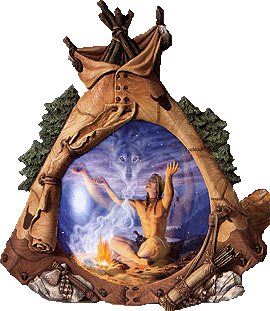
The bond between the Thracians and the wolves was also unbelievable. Admired for his intelligence and for his hunting abilities, the wolf served as a model for the Thracian hunters and warrior.
In ancient times some militaries brotherhoods had initiation rituals that were connected with the figure of the wolf; George Dumezil studied and demonstrated the survival of some military initiations at the Celts and the Romans.
The Thracians had themselves a system of believes and rituals for initiating the young warriors. In order to become a real warrior, the initiate had to magicaly assimilate the wolf behavior, while wearing the animal’s skin, symbol of his transformations in a wolf. As long as he was wearing the animal’s skin, the man became a wolf, operating a transfer of the wolf skills over him. He assumed the wolf’s main skills, he loosed the contact with the surrounding world and behaved appropriate: aggressive, with courage, with power, terrorizing his adversaries…
The Thracians also believed that the warrior cod send the “wolf” outside his body, thus the wolf would fight on the battlefield, while the body of the warrior remained home, laying in bed. This way the warrior’s spirit possessed all the wolf skills and cod attack enemies well beyond the area were the body of the warrior remained, proving extraordinary courage and ferocity in combat. But the warrior’s spirit transformed in a wolf wasn’t invincible. When the wolf was hurt, the wound would appear also on the warrior’s body, and if the wolf died, the warrior’s body would also die.
Of all the Thracian tribes, the Dacians (roman name or also known as Getae, their greek name) would identify themselves the most with the wolf. They called themselves “wolves” or “the ones who are like the wolves”. Strabon, the famous historian named them “daoi”, meaning wolves. The flag that they unfurled in battle was composed of two pieces: a wolf’s head ending with a snake’s body. In Moesia Inferior (roman province inhabited by Dacians) existed the city named Daous- Dava literary meaning the city of the wolves. All this evidence indicates that the wolf was more then an ordinary animal for them. The wolf was a relying friend. An old legend says that the Dacians who lived in mountains didn’t have dogs. They got along with the wolves and were under their protection. The wolves protected them when they were under attack, they guarded the herds and the horses and even the wives of the Dacians. The wolves were the ones who brought them food when they were up on the mountains. All the wealthy Dacians send their sons at a young age to live in the wildness among the wolves. And no one was aloud to return without a wolf brother. Between the Dacians and the wolves existed a strange bond, a brotherhood between man and animal.
One theory about the domestication of the dog is that it occurred when certain wolves of a suitable temperament joined bands of human hunter-gatherers due to their organizational similarities with wolf packs.
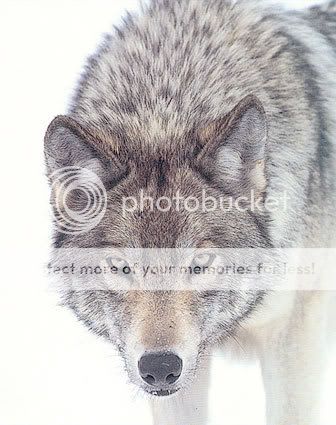
The fact that the Dacians devoted respect to the one thought to be the leader of the wolves, the mysterious White Wolf, it no surprise. About him the legends say that his spirit incarnated as many times as his help was required. When the capital of the Dacian kingdom, Sarmizegetusa was under siege by the Roman legions in 106 A.D. and because a traitor revealed the only way to penetrate the Dacian stronghold, the Spirit of The White Wolf incarnated himself in the body of an initiate in order to save them; he led the Dacians outside the stronghold through a secret network of underground tunnels and caves into a peaceful zone outside the conflict. His intention was to lead his people towards north in to the country of the bright people (hyperboreeans), but the traitor killed the initiate before his mission was completed. Even after this episode, the spirit of the white wolf never ceased to watch over the Dacian people and their descendants from the sky and continued to punish the traitors. It is also said that the spirit of the white wolf is the power who guided Saint Andrew through the daco-romanian realm. One thing is for sure: Saint Andrew is consideret to be the apostle of the wolves. The old ones say that in the night of 15 towards 16 January, the wolves gather in packs and howl all night long until morning. They dedicate their sadly “song” to an old deity either to The White Wolf or to Saint Peter, the patron of the wolves. On these days the wolves demand their victim.
It is said that in old times a lonely rider confronted year by year the winter cold and snows in order to leave the wolves, in the forest, a rich offering of sheep, lambs and deer.
The people considered this gift to be their part of the agreement of the peace pact. When the people didn’t respect the pact, meaning a lack of respect for the pack, the whole community had to suffer: the wolves attacked the villages. In time the old ones abandoned this custom, and replace it with others in order to protect themselves from the wolves rage. The above mentioned ritual was carried out by the east-European people, especially by the Dacian’s descendants…the Romanians.
Other Romanian old customs or rituals for gaining the protection on the wolves was to bake a special bread that had dust from wolf bones in his composition and eat it in the third day of Christmas. The ones who eat from the bread were never attacked by wolves. Also bathing a child in water were previously a wolf bathed will give him protection from wolf attacks.
It is impossible to ignore the fact that the figure of the White Wolf appears in the culture of two different nations, on two different cultures, the Dacians and the Native American Indians… Also let’s not ignore the close up between these legends and another one, a legend about the Greek god Apollo. The Olympian god traveled the whole world in search for places to build temples. Once he erected a temple on the White Island ( Leuke) situated in the Black sea near the Romanian coast. Tradition says that at the end of each autumn he would travel beyond the Rifee Mountains, towards the mysterious country of the hyperboreeans, where the god Boreas ruled in order to winter there. Boreas was also called Lycantotrophus, meaning wolf, usually he was mention in the mythology under the name The Bright Wolf.
Lycanthropy – myth and legends
From worshipping the wolf to the belief of becoming one, the step was a small one.
In folklore, lycanthropy is the ability or power of a human being to undergo transformation into a wolf. The transformation would be voluntary (a preternatural power) or involuntary (a curse). The term comes from ancient Greek “lykánthropos”
The word can also be used transitively, referring to the act of transforming someone else into a Wolf, or Werewolf.
Folk-etymology also links the word to Lycaon, a king of Arcadia who, according to Ovid's Metamorphoses, was turned into a ravenous wolf in retribution for attempting to serve human flesh (his own son) to Zeus, who was disguised as a traveler, in an attempt to disprove the god's divinity. His name persists in time through the scientific names Canis lycaon and Canis lupus lycaon.
The lycanthropy is common in myths from all over the world.
There are women, so the Armenian belief runs, who in consequence of deadly sins are condemned to pass seven years in the form of a wolf. A spirit comes to such a woman and brings her a wolf's skin. He orders her to put it on, and no sooner has she done this than the most frightful wolfish cravings make their appearance and soon get the upper hand. She wanders forth only at night, when morning draws near she returns to human form and removes her wolf skin. In these cases the transformation was involuntary or virtually so. But side by side with this belief in involuntary metamorphosis, we find the belief that human beings can change themselves into animals at will and then resume their own form.
The Eskimos have a story about an old abandoned woman, Qisaruatsiaq, who turned in to a wolf in order to survive.
In Latvian mythology, the Vilkacis was a person changed into a wolf-like monster, though the Vilkacis was occasionally beneficial.
In Romanian folklore the Pricolici was an evil spirit, in witch some people transformed after death, spirit who took the shape of animals, especially wolves.
A Werewolf in folklore and mythology is a person who changes into a wolf, either purposely, by using magic, or after being placed under a curse. The medieval chronicler Gervase of Tilbury associated the transformation with the appearance of the full moon, but this concept was rarely associated with the Werewolf until the idea was picked up by modern fiction writers. Most modern references agree that a Werewolf can be killed if shot by a silver bullet, although this is more a reflection of fiction's influence than an authentic feature of the folk legends.
Historical legends describe a wide variety of methods for becoming a Werewolf. One of the simplest was the removal of clothing and putting on a belt made of wolf skin, probably a substitute for the assumption of an entire animal skin which also is frequently described. In other cases the body is rubbed with a magic salve. To drink water out of the footprint of the animal in question or to drink from certain enchanted streams were also considered effectual modes of accomplishing metamorphosis. Olaus Magnus says that the Livonian werwolves were initiated by draining a cup of specially prepared beer and repeating a set formula. It is also said that the seventh son of the seventh son will become Werewolf. Another is to be directly bitten by a Werewolf, where the saliva enters the blood stream. Various methods also existed for removing the beast-shape. The simplest was the act of the enchanter (operating either on himself or on a victim), and another was the removal of the animal belt or skin. To kneel in one spot for a hundred years, to be reproached with being a Werewolf, to be saluted with the sign of the cross, or addressed twice by baptismal name, to be struck three blows on the forehead with a knife, or to have at least three drops of blood drawn have also been mentioned as possible cures. Many European folk tales include throwing an iron object over or at the Werewolf, to make it reveal its human form. Becoming a Werewolf simply by being bitten by another Werewolf as a form of contagion is common in modern fiction , but rare in legend, in which Werewolf attacks seldom left the victim alive to transform.
In Romanian folklore, the Varcolac was a powerful werewolf like spirit who cod eat the Sun and the Moon thus generating the Moon phases and the solar eclipses. Anabaptized children, people who murder their relatives or ignore the traditions, or even people driven by hate or revenge cod generate a Varcolac. When transformed his soul cod lift up in the sky and devour the Sun and the Moon, but in this phase the body was vulnerable and if the body was killed or the link between the body and the soul was cut off the soul would be lost forever. It is said that when the Moon is red, his color is given by the blood flowing from the wounds caused by a Varcolac. In order to drive off the Varcolac people used noises created by metal objects like the church bells or clashing swords.
In Slavic mythology, the Werewolf is known under the names Volkodlak, Vlkodlak or Valkodlak. This creature is considered to be messenger of evil, a demonic creature with mystic powers.
Giant Wolves ?
The belief in Werewolves or werewolf like creatures was triggered by the worshipping or by the fearing of the wolf. In old forgotten times, times when the Earth was ruled by giant creatures, especially by giant mammals the human existence was always menaced by predators… cave bears, saber tooth tigers and dire wolves.
The Dire Wolf was a relative of the actual wolf; he was almost the same size but much stronger then a normal wolf. Despite superficial similarities in appearance, there were significant differences between the two species. The legs of the Dire Wolf were proportionally shorter and sturdier than those of the Gray Wolf, which suggests that the Dire Wolf was a poorer runner, and may have scavenged for food or hunted large, slower-moving prey. The Dire Wolf had a larger, broader head and smaller brain-case than that of a similarly-sized Gray Wolf, and had teeth that were quite massive. The Dire Wolf may have used its relatively large teeth to crush bones. The Dire Wolf co-existed with the Gray Wolf in North America for about 100,000 years. About 10,000 years ago the Dire Wolf became extinct. The distant memory of this creature may have influenced the belief in giant wolves and Werewolves. Today some scientists accept as a possibility that dire wolves or descendants of this specie might still survive in the remote wildness of Siberia and even in Canada. Presumed extinct animals were sighted in these areas, giant bears, large wolves and there are some testimonies even about mammoths, but like in the case of Bigfoot there haven’t been found real evidence yet.

One example of the survival of such creatures until modern times is the story that became a legend, the legend called The Beast of Gevaudan.
The Beast of Gévaudan (French: La bête du Gévaudan) was a legendary wolf-like creature that terrorised the former province of Gévaudan (modern day Lozère département), in the Margeride Mountains in south-central France from about 1764 to 1767. Many attacks took place - between 60 and 100 people were killed - and debate continues as to the Beast's true identity.
The Beast was described as being a wolf like creature the size of a cow, with a wide chest, a long sinuous tail with a lion-like tuft of fur on the end, and a greyhound-like head with small straight ears and large protruding fangs. The creature was said to have red fur, and a peculiar white stripe that ran down the length of its chest. The sole survivor of the attack, a young peasant girl, described it: "It was as large as a cow, with claws the size of a man's hand." It may have been able to leap up to thirty feet, according to analysis of some of its tracks. The creature's reported method of killing was unusual for a predator, often targeting the head, and ignoring the usual areas targeted by predators, including the legs and throat. Often the head was crushed or removed. It also seemed to target people over farm animals, reportedly having an aversion to cattle; many times it would attack someone while cattle were in the same field.
There were some reports that the beast was seen with another such animal, or with young; others state that the beast was with a man.
The French King Louis XV ordered the hunting down of the beast, but with no success, finally the creature was killed by a local hunter, Jean Chastel, using a silver bullet as the legend says, marking the end of the attacks.
Various explanations were offered at the time of the attacks. They ranged from exaggerated accounts of wolf attacks, to a loup-garou (Werewolf) all the way to the beast being a punishment from God, or perhaps an unholy creature summoned by a sorcerer.
Current opinions offer up the theory that the attacks were actually a serial killer, or group of serial killers, using wolf attacks to cover their own murders. Also sometimes mentioned are the theories that the beast may have been a Dire Wolf or even was a specially bred wolf-dog hybrid. With the killing of the creature the attacks stopped and a similar creature was never sited again…
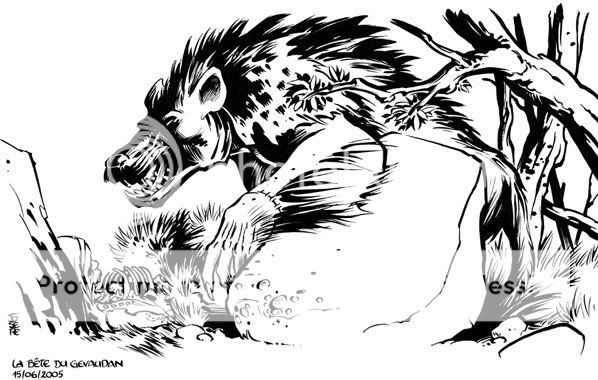
Epilogue
Now leaving behind the legends and myths, what can’t be dismiss is the fact that the wolf was admired for his intelligence and for his ability to hunt. Our ancestors observed it closely and managed to build a peaceful or fruitful relationship with him. But as the ages passed and the nations of the earth changed, the bond between the humans and the wolves weakened and deteriorated, for in our days to be completely lost. When the fear took the place of admiration, the human’s behavior towards this animal changed drastically.
Each people has his own ways of worshipping and dealing with the wolves, but apart from the mythology and the legends, the crude reality is that in present times there are few places were the wolves still live free and rule the nature. The lack of respect for life and nature of the modern man, augmented by the pass of time, has struck with an unimaginable cruelty these animals that became more and more scarce.
Today the wolf is not very pleased with the encounter of man, that’s why it’s very difficult to encounter wolves in the forest. They are afraid of man due to centuries of persecution and extermination.
The past relationship with the wolves has been replaced by a total inconsideration.
Wolves were once abundant and distributed over much of North America, Eurasia, and the Middle East. Today, for a variety of human-related reasons, including widespread habitat destruction and excessive hunting, wolves inhabit only a very limited portion of their former range. Though listed as a species of least concern for extinction worldwide, for some regions including the continental United States, the species is listed as endangered or threatened.
A few decades a go the wolf was threatened by extinction, today the wolf population in the world is stable, but for how long? When will we open our eyes and see that the wolf is a part of us, and by killing him, and harming the nature, we only harm our selves…?
What would our ancestors think about us and our modern almost non-existent relationship with the nature?
By ignoring the wolf, the bear, the eagle, more specifically the nature, we only ignore our past and our future…
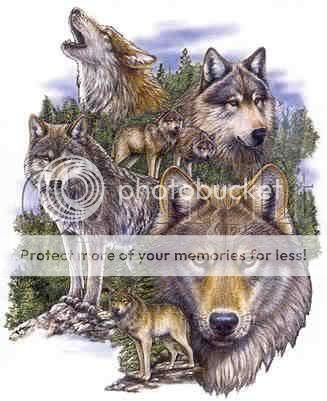






















COMMENTS
-
ShalinaChay
21:12 Aug 17 2012
You have done a beautiful job with this story. It is factual and full of opinion. Nice read.